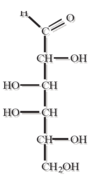Biochem - Carbohydrate Digestion Flashcards
(26 cards)
How many units make up:
- monosaccharides
- oligosaccharides
- polysaccharides

Name the sugar

mannose
name the sugar

D-Ribose
name the sugar

D-Galactose
name the sugar

D-Glucose
name the sugar

D-Fructose
Maltose
- What two monosaccharides compose maltose
- How are they linked together
- Where is maltose derived from
- 2 alpha-D-glucose
- alpha 1,4 glycosidic link
- maltose is derived from starch

Sucrose
- What two monosaccharides compose sucrose
- How are they linked together
- alpha-D-glucose + beta-D-fructose
- Glc-alpha-1-2Fru

Lactose
- What two monosaccharides compose Lactose
- How are they linked together
- Beta-D-Gal + Alpha-D-Glc
- Beta-1,4 glycosidic link

Starch
- is this a homopolysaccharide, heteropolysaccharide, or a glycoconjugate?
- where is it commonly found?
- How are the components linked together?
- name the two types and how they are different
- homopolysaccharide
- main storage of plant sugar
- linked with alpha glucose
- Amylose - 1,4 glc links - helical configuration
Amylopectin - 1,4 glc & 1,6 glc - branched structure

Glycogen
- is this a homopolysaccharide, heteropolysaccharide, or a glycoconjugate?
- where is it commonly found?
- How are the components linked together?
- homopolysaccharide
- main glc storage form in animals
- 1,4 and 1,6 alpha

Cellulose
- is this a homopolysaccharide, heteropolysaccharide, or a glycoconjugate?
- where is it commonly found?
- How are the components linked together?
- Why can’t humans digest this?
- homopolysaccharide
- chief constituent of plant cell walls
- linked by Beta-1,4 linkage
- Humans lack cellulase, which is needed to hydrolyze Beta-1,4 bonds

Heteropolysaccharides
- Are these branched or unbranched?
- List the common components of heteropolysaccharides
- What are the most abundant heteropolysaccharides int he body?
- Describe the charge of the most abundant heteroploysaccharides
- long unbranched containing a repeating disaccharide unit
- Disaccharide unit of a modified sugar and a uronic acid
Such as: N-acetylgalactosamine (GalNAc) or N-acetylglucosamine (GlcNAc)
&
Glucuronate or iduronate - Glycosaminoglycans (GAGs)
- highly negative charged molecules

Hyaluronates, chondroitin 4- and 6-sulfates, keratan sulfates, dermatan sulfates, and heparin & heparan sulfates are examples of….
Homopolysaccharides
Heteropolysaccharides
Glycoconjugates
Heteropolysaccharides
What are the three main types of glycoconjugates?
Proteoglycans
Glycoproteins
Glycolipids
- Where are proteoglycans found?
- Vaguely describe their composition
- Found in the extracellular matrix
- GAG chains linked to core porteins
Give some examples of glycoproteins
antibodies, blood types (A, B, AB, O), hormones (FSH, LH, TSH)
Where are some prominent places that glycolipids reside?
nerve tissues (brain), cell membranes, gangliosides
- How are monosaccharides absorbed by the intestinal lining?
facilitated diffusion
Maltase
- What type of bond does it cleave?
- What is its substrate
- What are its products?
- alpha 1,4 bonds
- malto-oligosaccharides
- glucose
Sucrase
- What type of bond does it cleave?
- What is its substrate
- What are its products?
- Hydrolyzes sucrose and maltose
alpha 1,4(glc-glc) and alpha-beta 1,2(glc-fru) - sucro and malto-oligosaccharides
- glucose and fructose
Isomaltase
- What type of bond does it cleave?
- What is its substrate
- What are its products?
- alpha 1,6 bonds (glc)
- alpha-dextrins
- glc
Lactase
- What type of bond does it cleave?
- What is its substrate
- What are its products?
- Beta-glycosidases
- Lactose
- Glc and Gal
Trehalase
- What type of bond does it cleave?
- What is its substrate
- What are its products?
- Trehalose
- Trehalose
- glc



